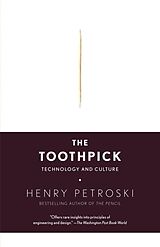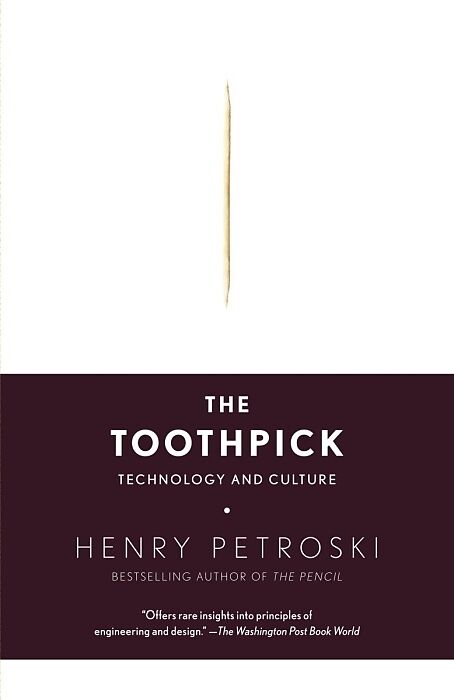The Toothpick
Einband:
Kartonierter Einband
EAN:
9780307279439
Untertitel:
Technology and Culture
Genre:
Geschichte
Autor:
Henry Petroski
Herausgeber:
Random House N.Y.
Anzahl Seiten:
464
Erscheinungsdatum:
04.11.2008
ISBN:
978-0-307-27943-9
Zusatztext "Offers rare insights into principles of engineering and design." The Washington Post Book World Delightful . . . Mr. Petroski combines historical narrative with technical expertise to compelling affect. New York Sun "I'll never look at a toothpick in the same way." Jeri Krentz! The Charlotte Observer Petroski writes . . . with the observant eye of an engineer and the imaginative heart of a novelist. Los Angeles Times Informationen zum Autor Henry Petroski is the Aleksandar S. Vesic Professor of Civil Engineering and a professor of history at Duke University. The author of a dozen previous books, he lives in Durham, North Carolina. Klappentext A celebration culture and technology! as seen through the history of the humble yet ubiquitous toothpick! from the best-selling author of The Pencil . From ancient Rome! where emperor Nero made his entrance into a banquet hall with a silver toothpick in his mouth! to nineteenth-century Boston! where Charles Forster! the father of the American wooden toothpick industry! ensured toothpicks appeared in every restaurant! the toothpick has been an omnipresent! yet often overlooked part of our daily lives. Here! with an engineer's eye for detail and a poet's flair for language! Henry Petroski takes us on an incredible tour of this most interesting invention. Along the way! he peers inside today's surprisingly secretive toothpick-manufacturing industry! and explores a treasure trove of the toothpick's unintended uses and perils! from sandwiches to martinis and beyond. Prologue The plain wooden toothpick, it may be argued, is among the simplest of manufactured things. It consists of a single part, made of a single material, intended for a single purposefrom which it gets its simple name. It is also among the most convenient and ready of things. It can be used directly out of the boxthere being no instructions to read, no parts to assemble, no priming or booting required, and no maintenance expected. When it has served its purpose, it is simply discarded. Such simplicity of design and use might lead one to expect an equally simple and straightforward history, one easily researched and explicated by a student doing a term paper. In the twenty-first century, such a student would very likely navigate around the World Wide Web via Google or some other digital search engine and come up with enough snippets to stitch together a plausible storyas long as the sources were unquestioned, the gaps glossed over, and the contradictions ignored. Of the quotations rustled up from the Web and corralled at the beginning of this book, every one but the statement about generating power from wood waste is at best a half-truth. In fact, the full and true story of something even so simple as the toothpick cannot easily be gleaned from the Internet alone. Unfortunately, more traditional sources of information and scholarship, such as manuscripts, articles, books, and other written materials in archives and analog libraries, also often provide sparse, erroneous, and contradictory information for topics considered too banal for and thus neglected by scholars seeking to pursue grander things and themes. The very simplicity and banality of the thing made the toothpick and its manufacture an artifact of tacit knowledge and trade secrets. Even in the late twentieth century, Japanese visitors who showed up at a Maine toothpick factory were turned away, lest they see the tricks of the trade. An American scholar, who should hardly have been seen as a potential competitor, was similarly denied entrance to a Minnesota counterpart. He had to go to Sweden to see some toothpicks being made. Secrecy coupled with a dearth of reliable, confirmable documentary material makes the task of uncovering the real story of a common object a challenge for ordinary scholarship relying on the usu...
"Offers rare insights into principles of engineering and design."—The Washington Post Book World“Delightful . . . Mr. Petroski combines historical narrative with technical expertise to compelling affect.” —New York Sun"I'll never look at a toothpick in the same way." —Jeri Krentz, The Charlotte Observer“Petroski writes . . . with the observant eye of an engineer and the imaginative heart of a novelist.” —Los Angeles Times
Autorentext
Henry Petroski is the Aleksandar S. Vesic Professor of Civil Engineering and a professor of history at Duke University. The author of a dozen previous books, he lives in Durham, North Carolina.
Klappentext
A celebration culture and technology, as seen through the history of the humble yet ubiquitous toothpick, from the best-selling author of The Pencil.
From ancient Rome, where emperor Nero made his entrance into a banquet hall with a silver toothpick in his mouth, to nineteenth-century Boston, where Charles Forster, the father of the American wooden toothpick industry, ensured toothpicks appeared in every restaurant, the toothpick has been an omnipresent, yet often overlooked part of our daily lives. Here, with an engineer's eye for detail and a poet's flair for language, Henry Petroski takes us on an incredible tour of this most interesting invention. Along the way, he peers inside today's surprisingly secretive toothpick-manufacturing industry, and explores a treasure trove of the toothpick's unintended uses and perils, from sandwiches to martinis and beyond.
Leseprobe
Prologue
The plain wooden toothpick, it may be argued, is among the simplest of manufactured things. It consists of a single part, made of a single material, intended for a single purpose–from which it gets its simple name. It is also among the most convenient and ready of things. It can be used directly out of the box–there being no instructions to read, no parts to assemble, no priming or booting required, and no maintenance expected. When it has served its purpose, it is simply discarded.
Such simplicity of design and use might lead one to expect an equally simple and straightforward history, one easily researched and explicated by a student doing a term paper. In the twenty-first century, such a student would very likely navigate around the World Wide Web via Google or some other digital search engine and come up with enough snippets to stitch together a plausible story–as long as the sources were unquestioned, the gaps glossed over, and the contradictions ignored. Of the quotations rustled up from the Web and corralled at the beginning of this book, every one but the statement about generating power from wood waste is at best a half-truth.
In fact, the full and true story of something even so simple as the toothpick cannot easily be gleaned from the Internet alone. Unfortunately, more traditional sources of information and scholarship, such as manuscripts, articles, books, and other written materials in archives and analog libraries, also often provide sparse, erroneous, and contradictory information for topics considered too banal for and thus neglected by scholars seeking to pursue grander things and themes.
The very simplicity and banality of the thing made the toothpick and its manufacture an artifact of tacit knowledge and trade secrets. Even in the late twentieth century, Japanese visitors who showed up at a Maine toothpick factory were turned away, lest they see the tricks of the trade. An American scholar, who should hardly have been seen as a potential competitor, was similarly denied entrance to a Minnesota counterpart. He had to go to Sweden to see some toothpicks being made.
Secrecy coupled with a dearth of reliable, confirmable documentary material makes the task of uncovering the real story of a common object a challenge for ordinary scholarship relying on the usual scholarly sources. But there are other sources of in…

Leider konnten wir für diesen Artikel keine Preise ermitteln ...
billigbuch.ch sucht jetzt für Sie die besten Angebote ...
Die aktuellen Verkaufspreise von 5 Onlineshops werden in Realtime abgefragt.
Sie können das gewünschte Produkt anschliessend direkt beim Anbieter Ihrer Wahl bestellen.
Loading...
Die aktuellen Verkaufspreise von 5 Onlineshops werden in Realtime abgefragt.
Sie können das gewünschte Produkt anschliessend direkt beim Anbieter Ihrer Wahl bestellen.
| # | Onlineshop | Preis CHF | Versand CHF | Total CHF | ||
|---|---|---|---|---|---|---|
| 1 | Seller | 0.00 | 0.00 | 0.00 |
